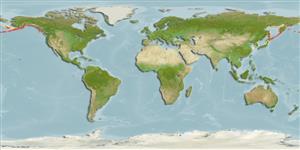Environment: milieu / climate zone / depth range / distribution range
Ecology
Marine; demersal; depth range 0 - 80 m (Ref. 58017). Temperate
North Pacific: Japan to the Gulf of Alaska.
Size / Weight / Age
Maturity: Lm ? range ? - ? cm
Max length : 21.0 cm TL male/unsexed; (Ref. 2850)
Dorsal spines (total): 2; Dorsal soft rays (total): 41 - 45; Anal spines: 1 - 2; Anal soft rays: 29 - 34. Pelvic fin thoracic, consisting of 1 spine and 5 soft rays, not covered with scales. Length of scaled portion of caudal fin less than 1/2 its whole length. Maxillary extending to below about middle of eye. Attains about 20 cm SL.
Body shape (shape guide): elongated; Cross section: circular.
Inhabits tide pools and shallow inshore areas (Ref. 2850).
Life cycle and mating behavior
Maturity | Reproduction | Spawning | Eggs | Fecundity | Larvae
Eschmeyer, W.N., E.S. Herald and H. Hammann, 1983. A field guide to Pacific coast fishes of North America. Boston (MA, USA): Houghton Mifflin Company. xii+336 p. (Ref. 2850)
IUCN Red List Status (Ref. 130435: Version 2025-1)
Threat to humans
Harmless
Human uses
Tools
Special reports
Download XML
Internet sources
Estimates based on models
Preferred temperature (Ref.
123201): 1.9 - 7.9, mean 3.6 °C (based on 316 cells).
Phylogenetic diversity index (Ref.
82804): PD
50 = 0.5703 [Uniqueness, from 0.5 = low to 2.0 = high].
Bayesian length-weight: a=0.00389 (0.00180 - 0.00842), b=3.12 (2.94 - 3.30), in cm total length, based on all LWR estimates for this body shape (Ref.
93245).
Trophic level (Ref.
69278): 3.6 ±0.3 se; based on size and trophs of closest relatives
Resilience (Ref.
120179): High, minimum population doubling time less than 15 months (Preliminary K or Fecundity.).
Fishing Vulnerability (Ref.
59153): Low vulnerability (11 of 100).
🛈
